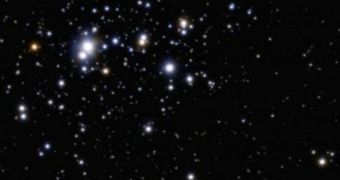Carina Nebula is undoubtedly one of the most renowned space structures, having been made popular by the fact that it houses Eta Carinae, one of the most massive and wildest stars ever noticed inside the Milky Way. But the nebula also houses numerous other formations of interest, including a fairly large number of stellar clusters. One such formation is Trumpler 14, which astronomers estimate is only one million years old. As far as the Universe is concerned, the cluster appeared just a moment ago.
But this was the target of a new set of scientific observations, carried out by the European Southern Observatory's (ESO) Very Large Telescope (VLT). In order to get the amazingly clear photo of the cluster, which is located some 8,000 light-years away, the science team used the Multi-conjugate Adaptive optics Demonstrator (MAD) instrument, which relied on adaptive optics to make its observations. This means that it is able to correct the diffractions, reflections and other interferences that the Earth-based telescopes detect on account of the fact that they have to peer through the atmosphere. With MAD, it's as if the layer of gas around the planet doesn't even exist.
MAD is also able to perform these amazing corrections over impressively large patches of skies, better than any other instrument featuring the adaptive optics technology, the ESO team says. Adaptive optics systems work by means of a computer-controlled deformable mirror that counteracts the image distortion introduced by atmospheric turbulence. They are based on real-time optical corrections computed at a very high speed, of several hundreds of times each second, from image data obtained by a wavefront sensor – a special camera – that monitors light from a reference star.
The new observations also refined the age of the cluster, which was proven to be only 500,000 years old. Thus far, the astronomers have counted more than 2,000 stars in a region of space just six light-years across. To put things into perspective, all those stars fit in roughly twice the distance between the Sun and its closest stellar neighbor. The objects detected in Trumpler 14 ranged in size from only a small fraction of the Sun's mass to several tens of times that mass. The largest is a celestial body known as HD 93129A, a supergiant more than 80 times heavier than the Sun, and also one of the most luminous stars in the galaxy.

 14 DAY TRIAL //
14 DAY TRIAL //